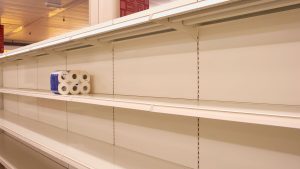 The COVID-19 outbreak has created a strange new world for us all. Like all strange new worlds, we need to adapt to the new realities and adapt quickly, especially when it comes to our businesses large and small.
The COVID-19 outbreak has created a strange new world for us all. Like all strange new worlds, we need to adapt to the new realities and adapt quickly, especially when it comes to our businesses large and small.
In my last article, I laid out an immediate step-by-step triage method for your company to react in a more positive way to this unfolding global crisis. In this article, I’ll explore ways to adapt your company’s offerings, and possibly even your guiding mission, to better sync with today’s very different world.
No matter what business you are in, a few weeks ago, your company was humming along. You were well into 2020, executing your well-conceived plans, and everything was going great.
Then the world changed. Luckily, these kinds of quick, unexpected changes don’t happen too often.
If you were smart, you froze your advertising, public relations messaging, and product development. The world has changed, and you need to change the way you communicate and develop products/services.
But now what?
The advertisements I heard while listening to CNBC this morning bounced between off-tone pre-COVID-19 crisis bouncy other-worldly ads and just a few that were obviously better targeted to the current situation. Those advertisers took care to match their message to the current crisis.
Companies that adapt quickly to this crisis will get through it with minimum damage. Companies with the same old pre-crisis messaging will come across as tone-deaf, see no results from their messaging, and be remembered poorly when this crisis passes.
As you start to build your crisis strategy, plan, and tactics (you may even consider a temporary mission pivot) here is something to think about:
How can you be more like toilet paper?
You’ve seen the crazy toilet paper hoarding news stories. People irrationally stocking up on more toilet paper than they could possibly use. Store shelves going empty. Toilet paper prices spiking in some places.
What is this all about? Toilet paper will not cure COVID-19.
Unfortunately, with most people’s frazzled psychological state, toilet paper is the only thing they are buying beside food. They may have totally blocked out your product or service. This may call for a temporary pivot of your product/service messaging and maybe even your company mission statement.
The key to making the right choices during this crisis (and probably forever) is to start with solid design/decision-making criteria. Jumping straight to possible solutions without creating a long and thoughtful list of criteria can lead to bad decision making that could take months to fix.
As I dug deeper into this crazy toilet paper hoarding situation, I identified a few criteria that might help guide all companies looking for a temporary COVID-19 crisis pivot.
But first, let’s look at a list of what I scooped up from about twenty articles on this toilet paper hoarding phenomenon. Experts of many flavors—economists, psychologists, etc…–looked at it from many different angles. Here is a summary:
- People think it will run out, and they will not get any.
- Seeing empty store shelves reinforces the fear of missing out.
- It gives people a sense of control when they really have little, if any, control.
- People can do something in an environment of great uncertainty.
- Uncertainty and anxiety are fed by conflicting information combined with no idea about the time frame or what may actually happen.
- It is really not a solution to the real problem. “Toilet paper is not an effective way to prevent getting the Coronavirus, but they’re selling out,” said health secretary, Alex M. Azar II.
- People are not using more toilet paper, but they buy more anyway.
- When stores limit the quantity people can purchase, it fuels fear and makes people want to buy more.
- This is truly “irrational” behavior.
- Toilet paper is something that is cheap to buy, that we can store easily, and we know in the back of our minds that we are going to use anyway.
- People are reacting to the fear of unimaginable potential loss and looking for a comfort item. Just one thing to make them feel better.
- People crave an illusion of control when little if any control is possible.
- Watching others stockpile can unsettle people and make them act irrationally to buy more than they need or could reasonably use.
- Some people have the perception that toilet paper is the new currency. It has more value now than in the past, and its value is on the rise.
- This addresses a basic need, and no matter how much you buy, you will eventually use it.
- It keeps people feeling safe when they have this one thing that will at least keep them from being in complete squalor.
- It’s a coping mechanism to help them with their panic. A diversion.
- Somehow seeing that mountain of hoarded toilet paper gives them a sense of satisfaction.
- There is a fear of contagion. Conflicting messages breed fear.
- Without clear messages and information, people are associating this crisis with past similar events like the Spanish flu and assuming the worst will happen.
- You aren’t safe anywhere. Fear is worldwide, and the numbers keep going up.
- People will over-prepare. It’s all they can do when they do not feel in control.
So, what would be included in a potential be-the-toilet-paper design criteria list for your company to consider?
This list could guide you in product/service pivoting and messaging. I weeded out some things from the list above, summarized a few others, and stated them so that they apply better to a company trying to pivot in these crazy times:
☐ Give them a chance to do something—some action—with some type of certain outcome.
☐ Be the comfort item in a time of potential unimaginable loss and confusion.
☐ Be the one thing that can make a perceived difference right now to make their lives just a little bit better—guaranteed.
☐ Try to give people some perceived sense of control.
☐ Try to create a perceived scarcity. Things might run out, and they will miss out.
☐ Try to provide a feeling of keeping people safe. You have the one thing that could at least keep them from descending into the equivalent of complete squalor.
☐ Show the scarcity using something visual. Example: Only a certain number of your widgets are still available out of the thousands you initially offered.
☐ Have a definite time frame. Certainty is good.
☐ Be consistent and concise with your information and messaging. Give one clear message.
☐ Offer something with lasting value, even if you don’t use it all right now.
☐ Limit quantities to which people have access.
☐ Provide a feeling of control when little control is possible.
☐ Visually show others stockpiling what you have.
☐ Show how your offering could be more valuable than in the past, and in this new world situation, its value is on the rise.
☐ Show how your product/service addresses a basic need, and no matter how much the person buys, they will eventually use it.
☐ Provide a coping mechanism to help people with their panic. A diversion. Something they can do to feel a little bit of control.
☐ Provide a safe space. What happens in the world is one thing, but you are safe here.
I know the list is long, so if your pivot hits just a few of these, you should be okay. If you hit none of these, then you need to take a closer look at what you’re doing and why. Your tone will be crucial.
The key is to pivot away from the way you were doing things before this crisis escalated.
This is a whole new world, and you need to change.





